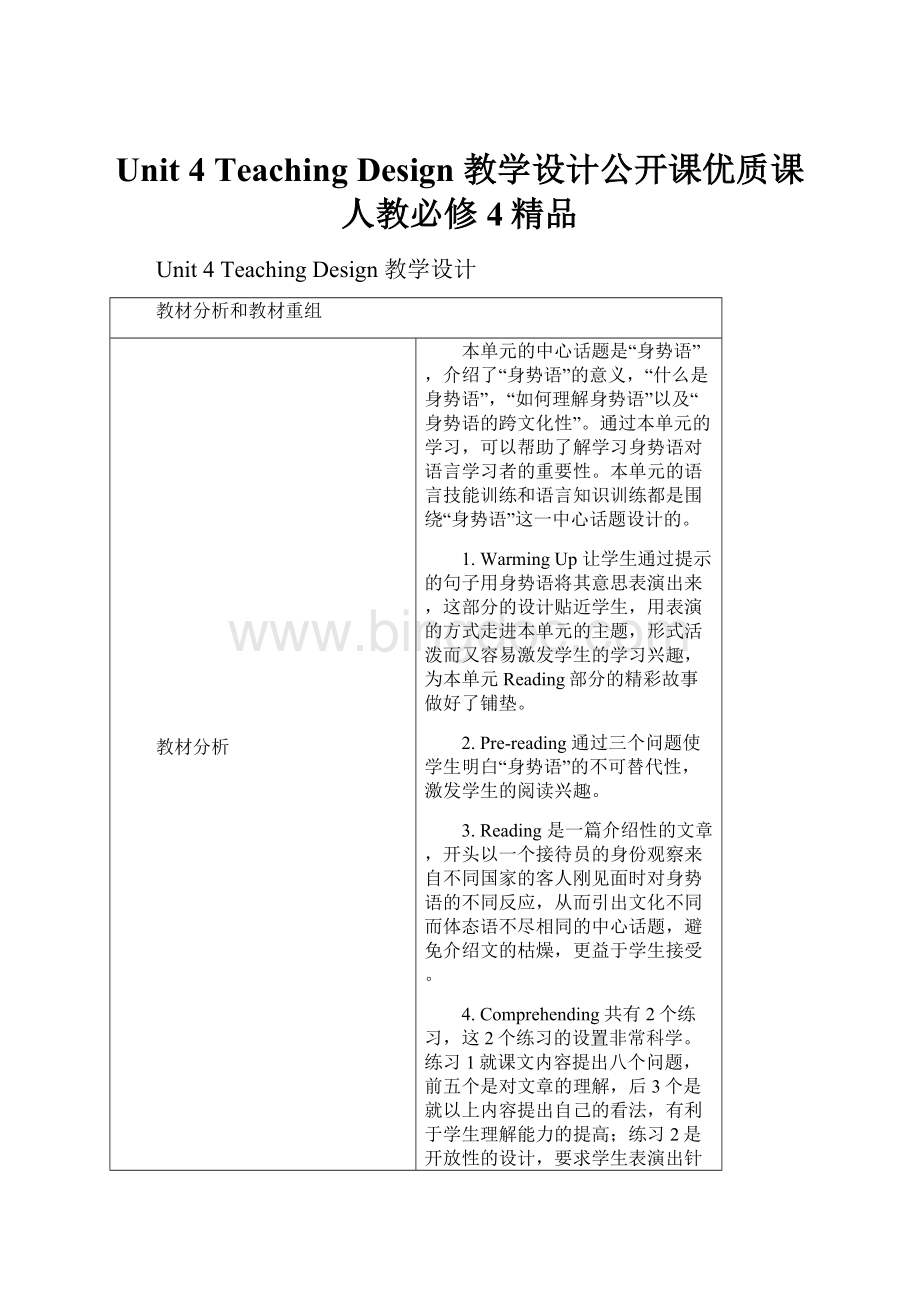Unit 4 Teaching Design 教学设计公开课优质课人教必修4精品.docx
《Unit 4 Teaching Design 教学设计公开课优质课人教必修4精品.docx》由会员分享,可在线阅读,更多相关《Unit 4 Teaching Design 教学设计公开课优质课人教必修4精品.docx(19页珍藏版)》请在冰点文库上搜索。

Unit4TeachingDesign教学设计公开课优质课人教必修4精品
Unit4TeachingDesign教学设计
教材分析和教材重组
教材分析
本单元的中心话题是“身势语”,介绍了“身势语”的意义,“什么是身势语”,“如何理解身势语”以及“身势语的跨文化性”。
通过本单元的学习,可以帮助了解学习身势语对语言学习者的重要性。
本单元的语言技能训练和语言知识训练都是围绕“身势语”这一中心话题设计的。
1.WarmingUp让学生通过提示的句子用身势语将其意思表演出来,这部分的设计贴近学生,用表演的方式走进本单元的主题,形式活泼而又容易激发学生的学习兴趣,为本单元Reading部分的精彩故事做好了铺垫。
2.Pre-reading通过三个问题使学生明白“身势语”的不可替代性,激发学生的阅读兴趣。
3.Reading是一篇介绍性的文章,开头以一个接待员的身份观察来自不同国家的客人刚见面时对身势语的不同反应,从而引出文化不同而体态语不尽相同的中心话题,避免介绍文的枯燥,更益于学生接受。
4.Comprehending共有2个练习,这2个练习的设置非常科学。
练习1就课文内容提出八个问题,前五个是对文章的理解,后3个是就以上内容提出自己的看法,有利于学生理解能力的提高;练习2是开放性的设计,要求学生表演出针对不同国家的人问候时的身势语,为进一步了解异国文化做准备。
5.LearningaboutLanguage分为两部分,Discoveringusefulwordsandexpressions是本单元的词汇练习题;Discoveringusefulstructures是本单元的语法练习题,通过本单元的学习,要求学生熟练掌握-ing形式作定语和状语的语法功能。
6.UsingLanguage分为三部分,Reading,andwriting部分要求学生通过阅读另一篇文章了解更多的身势语文化并就此写一篇作文评价积极的身势语和消极的身势语,从而吸取精华去其糟粕,弘扬积极的文化精神。
Listening,writingandspeaking要求通过六幅图和听力内容说出故事中的体态语言,并用相关句型把它写出来,有利于学生写作能力的提高。
第三部分speakingandwriting通过观察讨论林珮的体态语言,分析她的心态,并给她提出建议,这是由身势语引出的一个开放性写作。
教材重组
1.将WarmingUp,Pre-reading,Reading与Comprehending整合在一起上一节“阅读课”。
2.将LearningaboutLanguage和Workbook的usingwordsandexpressions及usingstructures整合在一起上一节“语言学习课”。
3.将UsingLanguage设计为一节包括听说读写在内的“综合技能课
(一)”。
4.将Workbook的READINGANDLISTENING和TALKING结合在一起上一节“听说课”。
5.将Workbook的LISTENINGTASK,READINGANDWRITINGTASK和SPEAKINGTASK设计为一节“综合技能课
(二)”。
课时分配
1stPeriodReading
2ndPeriodLanguagestudy
3rdPeriodIntegratingskills(Ⅰ)
4thPeriodListeningandSpeaking
5thPeriodIntegratingskills(Ⅱ)
Part1:
TeachingDesign
(第一部分:
教学设计)
Period1:
Asamplelessonplanforreading
(COMMUNICATION:
NOPROBLEM?
)
Aims
Todevelopreadingability
Tolearnsomethingaboutbodylanguage
Procedures
I.Warmingup
Warmingupbyacting
Lookatthelistofinterpretationontherightsideofthechart.Performtheactionorthenonverbalbehaviorontheleftside.
ExamplesofBodyLanguage
Warmingupbydefining—Whatisbodylanguage?
●Thegestures,poses,movements,andexpressionsthatapersonusestocommunicate.
●Theoutwardsignsofapersonwhichindicatetheirinnerthoughtsorattitude.Forexample,abowedheadindicatessubmission,ahandoverthemouthindicatesthepersondoesn’twanttotalkorfeelstheirwordsaren’tworthlisteningto.Scratchingindicatesnervousness.Apersonpassinganotheronthestreetmightbowtheirheadasasubconscioussignofsubmission.
●Consciousorunconsciousbodilymovementsandgesturesthatcommunicatetoothersaperson’sattitudesandfeelings.Thismayalsoincludedress,facialfeatures,skincolourorotherpersonalmeansofcommunicationwithoutwords.
●communicationviathemovementsorattitudesofthebody
●Bodylanguageisabroadtermforseveralformsofcommunicationusingbodymovementsorgestures,insteadof,orasacomplementto,sounds,verballanguage,orotherformsofcommunication.Inturn,itisonecategoryofparalanguage,whichdescribesallformsofhumancommunicationthatarenotlanguage.
II.Pre-reading
1.Lookingandsaying
Lookatthemaninthepicturebelow.Whatdoeshesaytoyoubyhisbodylanguage?
Basically,howthe......doIknow?
Or,Idon’tknownothing!
Theshouldersarehunchedandthehandsareopensignifyingabigquestionmark.
2.Talkingandsharing
*Bodylanguageisthequiet,secretandmostpowerfullanguageofall!
*Accordingtoexperts,ournon-verballanguagecommunicatesabout50%ofwhatwereallymean(voicetonalitycontributes38%)whilewordsthemselvescontributeamere7%.
*Ourbodiessendoutmessagesconstantlyandoftenwedon’trecognizethatwe’recommunicatingalotmorethanwerealize.
*Ourunderstandinganduseofnon-verbalcuesinfacialexpressionarefamiliartousnearlyfrombirth
III.Reading
1.Listeningandreadingaloud
NowpleaselistenandthenreadaloudtotherecordingofthetextCOMMUNICATION:
NOPROBLEM?
Payattentiontothepronunciationofeachwordandthepauseswithineachsentence.
2.Readingandunderlining
Nextyouaretoreadandunderlinealltheusefulexpressionsorcollocationsinthepassage.Copythemtoyournotebookafterclassashomework.
CollocationsfromCOMMUNICATION:
NOPROBLEM?
send…todosth.派……做某事,meet…attheairport去机场接……,meetwith…偶遇;碰到,atahotel在旅馆里,representtheChinesegovernment代表中国政府,lookaround环顾四周;左顾右盼,inacuriousway以奇特的方式,befollowedby后面紧跟着,introduce…to…把……介绍给……,kiss…onthecheek吻……的面颊,stepback向后退,appearsurprised显得很吃惊,takeafewstepsawayfrom…躲开……几步,atthesametime与此同时,reachone’shandoutto…向……伸出手去,touchsb’shand碰到(接触)某人的手,greeteachother彼此问候,communicatewithspokenlanguage用口语交流,expressone’sfeelings表达某人的感情,useunspokenlanguage不用语言,keepphysicaldistance身体保持一定的距离,standcloseto…与……站得近,approach…closely向……靠近,shakehands握手,movebackabit向后退,nodat…向……点头,behavethesameway表现地一样,avoiddifficulty避免困难
3.Readingtoidentifythetopicsentenceofeachparagraph
Nextyouaretoskimthetexttoidentifythetopicsentenceofeachparagraph.
4.Readingandtransferringinformation
Readthetextagaintocompletethetable.Whereishe/shefrom?
Whatdoeshe/shedowhenhe/shemeetssomeoneattheairportforthefirsttime?
Name
Country
Action
Meaning
MrGarcia
JuliaSmith
GeorgeCook
AhmedAziz
MadameCoulon
Answersforreference
Name
Country
Action
Meaning
MrGarcia
Columbia
TouchingJuliaSmith’sshouldersandkissingheronthecheek
Greetingpeople
JuliaSmith
Britain
Steppingbackfrommen
Appearingsurprised
GeorgeCook
Canada
ReachinghishandouttotheJapanese
Greetingpeople
AhmedAziz
Jordan
Shakinghandswithmen,noddingatwomen
Greetingpeople
MadameCoulon
France
Shakinghandsandkissingeachothertwiceonthecheek
Greetingpeople
5.Readingandunderstandingdifficultsentences
Asyouhavereadthetexttimes,youcansurelytellwhichsentencesaredifficulttounderstand.Nowputyourquestionsconcerningthedifficultpointstotheteacher.
IV.Closingdown
Closingdownbydoingexercises
Toendthelessonyouaretodothecomprehendingexercises1and2onpage26and27.
Closingdownbychecking
Checksomeofthefollowingbasicnon-verbalcuesandyou’llrecognizethatyoualreadyspeakandtranslatemuchofthelanguage.
“I’msurprised!
”“I’mshocked!
”“I’msad!
”
AdditionalMaterials
Completethesummaryofthestorywithonewordineachblank.
FourvisitorsfromEurope,NorthAmerica,SouthAmericaandAsiameetata1_______hotelinShanghai.
Thereseemstohavebeensome2_______mistakesafterintroducedtoeachother.Mr.GarciafromColumbia3_______MsSmithfromBritain,toucheshershoulderandkissesheronthe4_______,causinghertostepawayin5_______.Mr.Cook,fromCanada,reachesouthishandtotheJapanesewho6_______,
Besidesspokenlanguage,peoplecommunicateby7_______language,thatis,learnedorcultural“bodylanguage”.However,notallculturesgreeteachotherthesameway.
Englishpeopleusuallydonotstand8______toothersortouchstrangerswhentheyfirstmeet.ButpeoplefromSpain,Italy,SouthAmericancountriesapproachothersclosely,eventouchthem.MostworldpeoplegreeteachotherbyshakinghandswhileJapanesepeopledosoby9_______.
PeoplefromJordanmovesclosetotheonetheygreet.PeoplefromFrancemaygreeteachotherbyshakinghandsandkissing.MenfromMiddleEastorsomeMuslimcountriesstandquiteclosetoothermentotalkandtheywillnotshakehandswithwomen.
Bodylanguageiseithergoodorbad.Agood10_______ofithelpsyoubettercommunicatewitheachother.
(Key:
1.major2.greeting3.approaches4.cheek5.surprise6.bows7.unspoken8.close9.bowing10.understanding)
Comprehensionquestions
1.Howdopeoplesendeachothermessage?
A.Onlybywords.B.Onlybybodylanguage.
C.Byneitherwordsnorbodylanguage.D.Bybothwordsandbodylanguage.
2.WhichofthefollowingisNOTtrueaccordingtothetext?
A.Ineverycountry,peopleshakehandswhentheymeeteachother.
B.PeoplefromSouthAmericancountrieslikestandingclosewhentheytalk.
C.It’snotacustomformentogreetaBritishladybytouchinghershoulderandkissinghercheek.
D.Studyingbodylanguageishelpfultoavoidmisunderstandingincommunication.
3.Whichofthefollowingcanserveasthetopicsentenceofthepassage?
A.Bodylanguagediffersfromculturetoculture.B.Peoplesendmessagesnotonlybywords.
C.Bodylanguageisnecessaryinourdailylife.D.Peopledon’tgreeteachotherinthesameway.
4.Fromthetextwecanconcludethat_____.
A.Bodylanguageismoreimportantthanwordsincommunication.
B.Weshouldbecarefulaboutbodylanguage.
C.Weshouldn’tusebodylanguagewhenwemeetforeigners.
D.Weshouldusebodylanguageasoftenaspossible.
(Key:
1.D2.A3.A4.B)
Notestosomedifficultsentences
1.Fourpeopleenterlookingaroundinacuriousway.四个人进来了,好奇地左顾右盼。
enter:
vt.enteraroomenteraschool/collegevi.enterinto
本句中enter用作不及物动词,lookingaroundinacuriousway是现在分词短语作主句的伴随状语。
Manypeoplecometothemeparks,lookingforthrillsandentertainment.
2.ThefirstpersonwhoarrivesisMr.GarciafromColumbia,closelyfollowedbyJuliafromBritain.
第一个到的是来自哥伦比亚的Garcia先生,紧跟在他后面的是来自英国的Julia.
whoarrives是定语从句修饰主语thefirstperson,closelyfollowedbyJuliafromBritain是过去分词短语作主句的伴随状语。
动词follow与Mr.Garcia构成逻辑上的动宾关系,所以用过去分词作状语。
3.Notallculturesgreeteachotherthesameway,noraretheycomfortabletouchingstrangersorbeingtoocloseortoofaraway.
各种文化背景下的人相互问候的方式不尽相同,接触陌生人、彼此靠得太近或距离太远,都会使他们感到不舒服。
句中notallculturesgreeteachotherthesameway是部分否定句,相当与allculturesdon’tgreeteachotherthesameway。
nor、neither置于句首,句子用部分倒装,即把助动词或系动词放到主语前面。